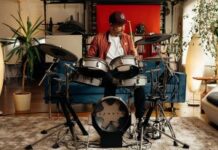
Sine is Verso Instruments’ latest and greatest experimental guitar
Every year, the NAMM Show in California brings the music industry together under one very large roof to check out the newest and most interesting instruments. In 2025, one piece of gear that turned an inordinate number of heads was the latest creation from Verso Instruments. And with good reason: it looks less like a guitar than something yanked straight from the pages of a mid-century furniture catalogue.
A sleek mix of wood and metal, bold colours and minimalist approach, the new Sine is not of any mainstream guitar-design lineage – but one spawned by a one-man company in Germany that embraces the unexpected. What’s Verso’s design philosophy? “Building funky stuff and not rejecting the errors is a big part of what I’m interested in,” says founder Robin Stummvoll.
The Verso Instruments Sine is on the Guitar.com Cover. Image: Rachel Billings for Guitar.com
Stummvoll’s path to building his own instruments under the Verso name began as a deliberate leap away from tradition. A lifelong guitarist who started his first punk band at 13, he’d found himself neglecting the instrument while studying for his degree in industrial design. “I found it interesting to look at why I was abandoning it more and more, and how to make it more appealing to me again,” he explains. He decided to use his degree’s final project to re-enter the world of guitar – his own way.
“I started doing a lot of research, and I found that the guitar – the electric guitar especially – is carrying this burden of the iconography of big rock stars,” he explains. “And I totally get that. I’m a fanboy of many guitar heroes, Hendrix and so on. But on the other hand, I feel it’s a big difference to, say, the violin or piano, where you just have this archetypal instrument: people don’t really expect you to play any one specific thing.”
“Building funky stuff and not rejecting the errors is a big part of what I’m interested in” – Robin Stummvoll, founder of Verso Instruments
Stummvoll started to look at how that archetype might be expressed for the electric guitar. “A ridiculous thought,” he says, “as that’s basically what Leo Fender did with the Telecaster. But I thought it would be interesting to start with the most minimalist guitar that I could and go from there.”
The centerpiece of Verso Instruments’ first three guitars is a curved sheet of steel, which takes the place of a traditional body. The pickups, being magnetic, aren’t attached in any one place. Instead, you’re free to move them around underneath the strings as you see fit. Moveable pickups are not totally new, but this approach to achieving them certainly is.
This ever so slightly bouncy bent steel body was introduced with Verso’s first guitar, Cosmo, launched in 2020. Two variations came in the years following, the Gravis and Orbit, a bass and baritone respectively. But Sine redefines the formula once more with the Sine Pad, one of those rare genuine innovations on the electric guitar’s design.
Image: Rachel Billings for Guitar.com
Happy accident
Sine’s main body is now wood, and the steel plate with moveable pickups is now independent from the neck and bridge. And so when you press down on this pad, you increase the pickup-to-string distance for an interactive volume reduction. You can volume swell, you can do manual tremolo, and, thanks to a collaboration with renowned utility pedal manufacturer Lehle, you can output this bending motion as expression, CV or MIDI to control synths and pedals. The possibilities quickly start to boggle the mind.
The flexible pickup pad was inspired by the slight springiness of Cosmo’s body – something many would have considered a problem. “Maybe someone [else] would have screwed Cosmo together to keep it still,” Stummvoll adds. But after he seriously contemplated what use the springiness could bring, one man’s design flaw turned into Sine’s defining feature. “It was a quality you could dive into more. With Sine, that was the case – it was another happy accident.”
“I thought it would be interesting to start with the most minimalist guitar that I could” – Robin Stummvoll, founder of Verso Instruments
Stummvoll loved the idea for the Sine Pad from the beginning, but it wasn’t always going to be an actual Verso product. It was in 2024 when he actually decided to make Sine official. One of its most intriguing features also came about relatively late in the process: the electronics module, a collaboration with Lehle. Using a hall effect sensor, the Sine Pad’s motion is translated to your choice of CV, MIDI or expression – opening up endless control options for pedals, synths and more. “It is such a versatile and interesting instrument because of it,” Stummvoll says admiringly.
The result of using the expression outputs only get more complex when combined with the physical effects of using the Sine Pad. It is in some ways a volume control, but the effect it creates isn’t just a linear drop in signal. All sorts of tonal interactions happen as you move the pickups towards and away from the strings, including a slight signal created by the movement itself. Combine this with the MIDI and expression outputs and the guitar is perfect for tone-chasing far beyond the traditional.
Fittingly, then, one player who has been testing Sine out is Scott Harper, AKA Knobs, who you may know from his own excellent demos of outré pedals and his collaborative design work with Chase Bliss. “I think he’s the perfect person for it,” Stummvoll says. “He really dove deep into what’s possible – he’s still not figured out everything, but he definitely surprised me with certain combinations.”
Image: Rachel Billings for Guitar.com
Elements of surprise
An interesting consequence of attaching pickups to a big steel plate is that it ends up creating a pretty big microphone. “When you knock on the body, you really hear it,” Stummvoll says. “And if you record something and there’s a drummer in the same room, you can hear the drums in the guitar track.”
While this means that Sine isn’t technically recommended for high-gain, high-volume playing, Stummvoll doesn’t rule anything out. “People have proved me wrong before. I have players who use Cosmo for death metal. I don’t limit my guitars anymore, they’re really open for anything.”
The lively, microphonic sound was, like many other aspects of Sine, one more “happy little accident” that ended up informing a large part of the guitar’s personality. “It contributes to the sound of the guitar – the microphonic character is what I like about it,” says Stummvoll. “It’s funny, it sounds very wooden, ironically, and very open. And it’s really a shapeshifter in sound, of course, thanks to the moveable pickups.”
“It’s funny that we think of ‘play’ as something childish” – Robin Stummvoll, founder of Verso Instruments
But perhaps that woody, open sound isn’t so ironic. Despite the steel being a central element, Verso guitars feature wooden necks and, in the case of Sine, a mostly wooden body underneath that steel Sine Pad. “The warmth and feel of an instrument is very important,” Stummvoll says. “You don’t want to get rid of the heart of the guitar! If the body is sheet metal, you’ve got to be careful not to make it headless, or add an aluminium neck and make it too alien.”
And so Verso Instruments guitars do still display a lot of traditional guitar-making techniques, despite their out-there appearance. “The mixture of tradition and then something different is what’s appealing to me. That’s why I’m using very very traditional surface finishes for the necks, like oil and shellac polish.”
Image: Rachel Billings for Guitar.com
Time to play
Stummvoll had to deal with the odd cynical internet comment dismissing Sine as a “toy” or a “gimmick” – such is the lot of anyone who makes something new and weird, of course. But this sentiment can be particularly potent in the world of electric guitar, where 70-year-old designs are still broadly held up as the gold standard.
“It’s funny, as the electric guitar is a symbol of freedom and for breaking out of restrictions,” Stummvoll muses. “But in some ways it’s not that open. It can be conservative. Not all guitarists are conservative – but I find it very funny when I see some people comment on the work I do who are offended by certain guitars.”
Stummvoll isn’t insulted by comparisons to toys, either. “It’s funny that we think of ‘play’ as something childish,” he says. “Playing an instrument is a perfect example of how you can ‘play’ very seriously. I’m always wondering when we start to not play anymore and become adults. I try myself to keep that spark alive – and I think many artists do that.”
Image: Rachel Billings for Guitar.com
What will Verso do next to keep that spark alive, now that Sine is out? “I have an idea for a lap-steel guitar,” Stummvoll says. “I’m really not sure where it will lead me – maybe it’s more like a tabletop instrument for synthesiser geeks, maybe it’s more like a traditional lap steel. What I’m curious about is making something a bit more industrial, something I can assemble a bit more quickly and a bit more affordable. I haven’t built a prototype yet, so I’m curious if it will work!”
Whether it works or not is perhaps besides the point – instead, it’s Robin Stummvoll’s unending curiosity that remains the engine of Verso Instruments. Sine is a testament to what you can achieve when you turn tradition on its head and take that leap into the unknown.
This story appeared in the Guitar.com Magazine May/June 2025 issue.
Words: Cillian Breathnach
Photography: Rachel Billings
The post Sine is Verso Instruments’ latest and greatest experimental guitar appeared first on Guitar.com | All Things Guitar.
Source: www.guitar-bass.net












